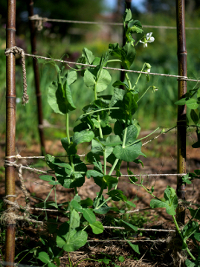|
Low Maintenance Gardening-VegetablesAre you looking for low maintenance vegetable gardening options? If so, then a combination of raised bed gardening and vertical gardening might be your answer. These two techniques can produce a good quantity of vegetables with much less weeding and digging. It also will save on space, which reduces the area that will need fertilizer and soil amending.
Raised Bed GardeningRaised bed gardening is one method that will save labor, especially if it is contained in a wood or block bed. Using the contained raised bed allows for the use of landscape fabric to block light to weeds and grass. This will drastically reduce the amount of weeding and upkeep you need to do all season, and so it is well worth doing. The use of hardware cloth will prevent rodents from entering the contained raised bed and chewing up the roots of your vegetables. It will also prevent the holes that make watering difficult. If you choose, you can also make raised garden beds in your regular garden. You won't have the weed snuffing advantage of landscape fabric, but you can amend smaller amounts of soil, garden the area more intensively, and get a head start on your garden because the raised bed will warm up faster and the seeds will germinate more quickly. To make these raised beds, you can dig up the top 6 inches of soil, add about 3 inches of compost, peat moss, and a thin layer of sterilized manure, and mix it together well. You want to make the beds only as wide as you can reach from either side, because the idea is that you don't ever step on the beds. This leaves the entire bed loose and fluffy. This will make it easy for plant roots to grow quickly and for water to penetrate the soil evenly. Vegetables can be planted a little closer together than usual, since there won't be paths between vegetables. This will help to conserve water by shading the soil. Weeds will be easier to pull up because of the loose soil, as long as you don't allow them to grow for too long. Vertical Gardening Techniques
If you plant corn, pole beans will climb the cornstalks, fertilizing the corn plants with the extra nitrogen they produce, and using the stalk as a pole. Tomato cages can be used with cucumbers, squash, and melons as well as tomatoes. You might even want to use twine hanging down from a pole that runs across the bed for tomatoes instead of stakes. This is not really necessary for determinate bush type tomatoes, but the indeterminate tomatoes will require some kind of support as they can grow very tall. Just put a small stake at the end of the twine into the soil next to the tomato plant. The important thing is find ways to keep plants growing upward and not sprawling all over the soil. The amount of vegetables you can grow in a bed will be higher in this way. Also, utilize the space around large vining vegetables with types that can be harvested in a few weeks, so that they are ready before the vines get large enough to take that space. Using the space in this way will reduce weeds by outcompeting them for space. It is a good idea to plant these vegetables near the edges of the bed, and use the area around the bed for them to climb. This way you maximize the space available in the bed for other vegetables. A net at one end can work well for a row of peas or beans. In the more intensive approach for planting in raised beds, you can have a low maintenance garden that produces as much or more than a larger area. All while having less area to water and weed. When a short season crop like lettuce is harvested, replace it immediately with another vegetable that has time to grow during the rest of the season. This increases production and reduces weeding You will find that raised beds will make low maintenance gardening possible. It is productive, conserves water and fertilizer, requires less seed, and less work. The vegetables will still taste great, and you will get that satisfaction of enjoyingbthe fruits of your labor with much less effort. Have fun!
from Low Maintenance Gardening to Vegetable Gardening Advice Home |





